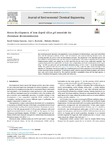Mostrar o rexistro simple do ítem
Green Development of Iron Doped Silica Gel Materials for Chromium Decontamination
| dc.contributor.author | Gómez-Carnota, David | |
| dc.contributor.author | Barriada, José Luis | |
| dc.contributor.author | Herrero, Roberto | |
| dc.date.accessioned | 2022-10-18T17:52:30Z | |
| dc.date.available | 2022-10-18T17:52:30Z | |
| dc.date.issued | 2022 | |
| dc.identifier.citation | David Gómez-Carnota, José L. Barriada, Roberto Herrero (2022). Green development of iron doped silica gel materials for chromium decontamination. Journal of Environmental Chemical Engineering, Volume 10, Issue 5, 108258. ISSN 2213-3437. https://doi.org/10.1016/j.jece.2022.108258. (https://www.sciencedirect.com/science/article/pii/S2213343722011319) | es_ES |
| dc.identifier.issn | 2213-3437 | |
| dc.identifier.uri | http://hdl.handle.net/2183/31835 | |
| dc.description.abstract | [Abstract] New hybrid polymeric materials were prepared by the polymerisation of sodium silicate, water, and hydrochloric acid, with the subsequent addition of iron. After the treatment with a natural reducing biomass extract, the resulting material was used in Cr(VI) decontamination processes. The preparation of the materials started with the synthesis of the polymeric base, and the successive modifications were made to maximise Cr(VI) removal. Characterization studies were carried out by SEM and EDS tests for each of the synthesised materials. The synthesised polymeric base (called GSP) was found to have a high affinity for Fe(II). An adsorption of 24.5 mg Fe(II)·g˗1 on GSP was achieved, with an associated adsorption energy of 34.5 kJ·mol˗1. In the decontamination studies, the polymeric base acts as a Supporting material for iron, while the main Cr(VI) scavenger is the adsorbed Fe. Chromium removal takes place by a combined process of Cr(VI) reduction to Cr(III) and adsorption of both chromium species at acidic pH. An adsorption model, based on statistical thermodynamics, and removal rates were used to study the process. The proposed material is sustainable, cheap and has high capacity to remove chromium from aqueous media quickly and effectively. | es_ES |
| dc.description.sponsorship | Authors wish to thank Agencia Estatal de Investigación (AEI) (Ministerios de Ciencia e Innovación y de Economía y Competitividad) for the financial support through the research projects PID2020–117910 GB-C22 and CTQ2016–80473-P cofounded with FEDER (UE) programme. Gómez-Carnota thanks Fundación Segundo Gil Dávila for the fellowship grant | es_ES |
| dc.language.iso | eng | es_ES |
| dc.publisher | Elsevier | es_ES |
| dc.relation | info:eu-repo/grantAgreement/AEI/Plan Estatal de Investigación Científica y Técnica y de Innovación 2017-2020/PID2020-117910GB-C22/ES/CARACTERIZACION FISICO-QUIMICA DE LAS PROPIEDADES ACIDO-BASE DE LA MATERIA ORGANICA DISUELTA DESDE EL SUELO HASTA EL OCENAO/ | |
| dc.relation | info:eu-repo/grantAgreement/AEI/Plan Estatal de Investigación Científica y Técnica y de Innovación 2013-2016/CTQ2016–80473-P/ES/EMPLEO DE BIOMASA PARA EL DESARROLLO DE NUEVOS METODOS DE SINTESIS DE NANOPARTICULAS MAGNETICAS RECUBIERTAS CON POLIMEROS DE IMPRESION MOLECULAR (MMIP-NP)/ | |
| dc.relation.uri | https://doi.org/10.1016/j.jece.2022.108258 | es_ES |
| dc.rights | Atribución-NoComercial-SinDerivadas 4.0 Internacional (CC BY-NC-ND 4.0) | es_ES |
| dc.rights.uri | https://creativecommons.org/licenses/by-nc-nd/4.0/ | * |
| dc.subject | Chromium elimination | es_ES |
| dc.subject | Polymerised silica gel | es_ES |
| dc.subject | Iron dopped material | es_ES |
| dc.title | Green Development of Iron Doped Silica Gel Materials for Chromium Decontamination | es_ES |
| dc.type | info:eu-repo/semantics/article | es_ES |
| dc.rights.access | info:eu-repo/semantics/openAccess | es_ES |
| UDC.journalTitle | Journal of Environmental Chemical Engineering | es_ES |
| UDC.volume | 10 | es_ES |
| UDC.issue | 5 | es_ES |
| UDC.startPage | 108258 | es_ES |
| dc.identifier.doi | 10.1016/j.jece.2022.108258 |
Ficheiros no ítem
Este ítem aparece na(s) seguinte(s) colección(s)
-
GI-METMED - Artigos [10]






